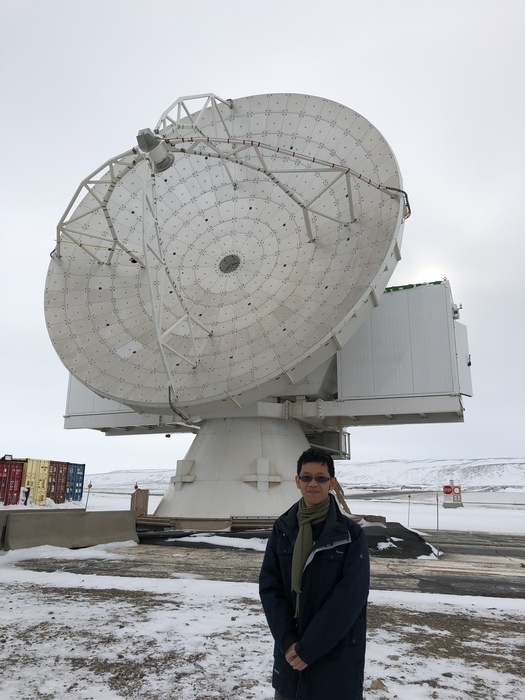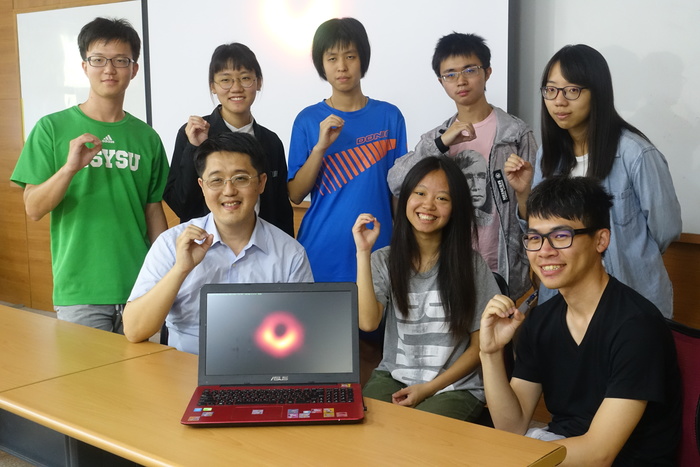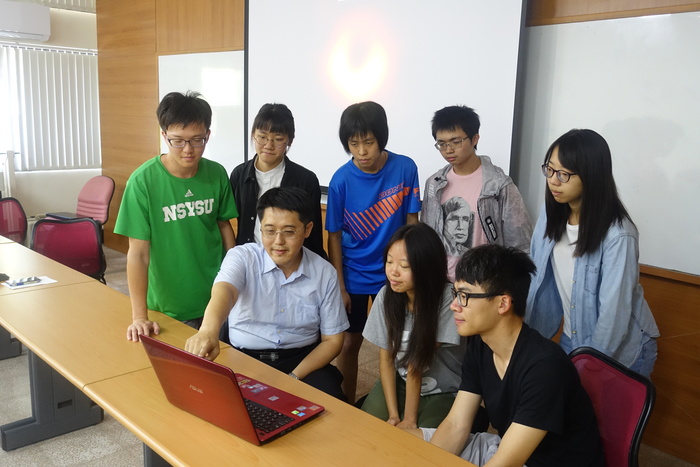Black holes are all the rage! A student from the Department of Physics, National Sun Yat-sen University, joins the black hole observation team of Academia Sinica



Scientists have recently obtained the first images of a black hole, setting a new milestone for scientific development. Cheng-yu Kuo, an assistant professor at the Department of Physics, National Sun Yat-sen University, has for eight years participated in the black hole observation project of the Institute of Astronomy and Astrophysics, Academia Sinica. He joined the faculty of National Sun Yat-sen University in 2015, actively nurturing new talents in astrophysics. One of his students, Wen-tse Chien, was invited onto the project for his outstanding academic performance, and he became the youngest member of Academia Sinica’s black hole observation project, which is the Taiwanese contingent of the Event Horizon Telescope (EHT) project.
“When Academia Sinica began its involvement in the project ten years ago, the team was far from optimistic,” remembered Kuo. He was invited to join the project by an academician of Academia Sinica, Tseng-Pu Ho, who is an accomplished astronomer. However, “finding a traditional astronomical telescope that could image a black hole is physically impossible, because the telescope would need to be as large as Earth.” Therefore, the EHT project scholars devised an alternative. They recruited the top-of-the-line radio telescopes from around the world and apply the technique of very-long-baseline interferometry (VLBI) for black hole imaging. This technique enables one to integrate all radio telescopes in the array and “simulate a telescope as large as Earth.” In this manner, a black hole was successfully captured in images.
VLBI is the specialty of Kuo, and Chien had worked in Kuo’s laboratory in National Sun Yat-sen University since his freshman year, learning theoretical modeling and data processing. Thanks to the recommendation of his advisor, Chien spent each summer vacation from his sophomore year on numerous projects of the Institute of Astronomy and Astrophysics, Academia Sinica. He learned how to operate the Yuan-Tseh Lee Array for Microwave Background Anisotropy and went to Hawaii to learn how to operate the Submillimeter array (SMA), which was one of the telescopes employed by Academia Sinica to image a black hole in the EHT project.
Because of his solid theoretical knowledge and practical experience, Chien was selected as a member of Academia Sinica’s EHT team at the age of 22, a commendable feat. He is currently stationed in Greenland on the Thule Air Base of the United States Air Force and operates Academia Sinica’s Greenland Telescope (GLT) as part of the EHT project. He likens the 24-hour all-weather observation tasks to a marathon; the extreme climate at the North Pole compels him to be constantly alert to whether the weather is suitable for observation, and the harsh conditions make daily life unimaginably difficult. He jokingly commented that because there was no toilet near the GLT, he had to answer the call of nature outside of the control room, braving low temperatures of −30 to −20 ºC. Moreover, “you have to watch out for polar bears when you relieve yourself at night. Bear spray must be carried at all times. It is a matter of life and death!”
Chien mentioned that during his university years he learned four programming languages and became proficient in data mining, machine learning, numerical computation, and numerical simulation. The ability to solve astrophysical problems using these skills laid a solid foundation for his work in the EHT project. “Astronomical research is a lonesome undertaking, but it is also a great adventure for the human mind.” Professor Kuo stressed that because the EHT project is recruiting talents from numerous fields, including astrophysics, civil engineering, and electrical engineering, he has high hopes of increased Taiwanese involvement in this international project, becoming the vanguard of scientific development.
“When Academia Sinica began its involvement in the project ten years ago, the team was far from optimistic,” remembered Kuo. He was invited to join the project by an academician of Academia Sinica, Tseng-Pu Ho, who is an accomplished astronomer. However, “finding a traditional astronomical telescope that could image a black hole is physically impossible, because the telescope would need to be as large as Earth.” Therefore, the EHT project scholars devised an alternative. They recruited the top-of-the-line radio telescopes from around the world and apply the technique of very-long-baseline interferometry (VLBI) for black hole imaging. This technique enables one to integrate all radio telescopes in the array and “simulate a telescope as large as Earth.” In this manner, a black hole was successfully captured in images.
VLBI is the specialty of Kuo, and Chien had worked in Kuo’s laboratory in National Sun Yat-sen University since his freshman year, learning theoretical modeling and data processing. Thanks to the recommendation of his advisor, Chien spent each summer vacation from his sophomore year on numerous projects of the Institute of Astronomy and Astrophysics, Academia Sinica. He learned how to operate the Yuan-Tseh Lee Array for Microwave Background Anisotropy and went to Hawaii to learn how to operate the Submillimeter array (SMA), which was one of the telescopes employed by Academia Sinica to image a black hole in the EHT project.
Because of his solid theoretical knowledge and practical experience, Chien was selected as a member of Academia Sinica’s EHT team at the age of 22, a commendable feat. He is currently stationed in Greenland on the Thule Air Base of the United States Air Force and operates Academia Sinica’s Greenland Telescope (GLT) as part of the EHT project. He likens the 24-hour all-weather observation tasks to a marathon; the extreme climate at the North Pole compels him to be constantly alert to whether the weather is suitable for observation, and the harsh conditions make daily life unimaginably difficult. He jokingly commented that because there was no toilet near the GLT, he had to answer the call of nature outside of the control room, braving low temperatures of −30 to −20 ºC. Moreover, “you have to watch out for polar bears when you relieve yourself at night. Bear spray must be carried at all times. It is a matter of life and death!”
Chien mentioned that during his university years he learned four programming languages and became proficient in data mining, machine learning, numerical computation, and numerical simulation. The ability to solve astrophysical problems using these skills laid a solid foundation for his work in the EHT project. “Astronomical research is a lonesome undertaking, but it is also a great adventure for the human mind.” Professor Kuo stressed that because the EHT project is recruiting talents from numerous fields, including astrophysics, civil engineering, and electrical engineering, he has high hopes of increased Taiwanese involvement in this international project, becoming the vanguard of scientific development.
Click Num:
Share
